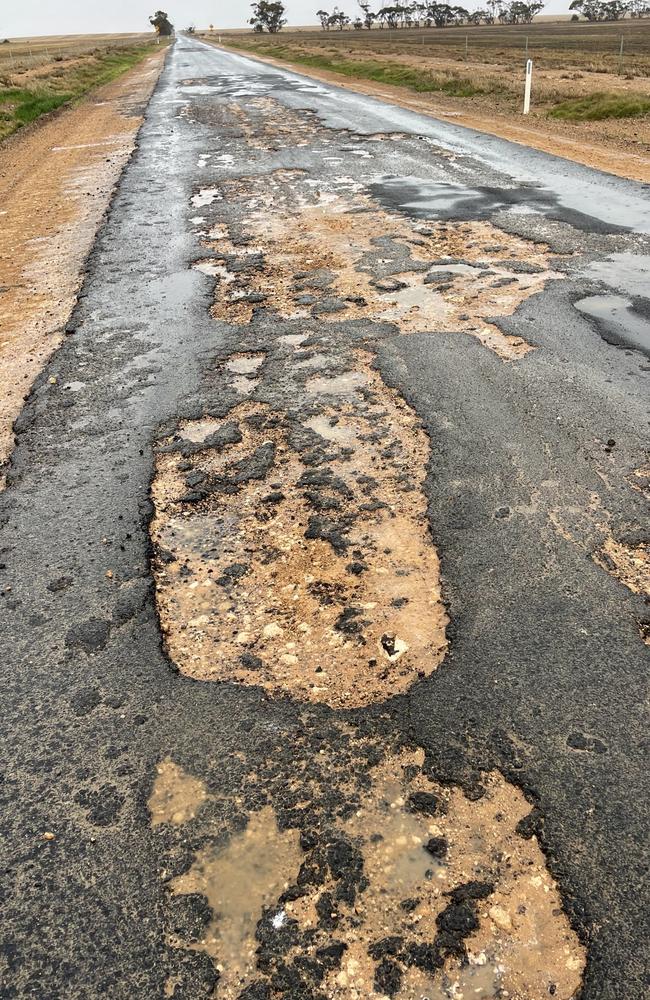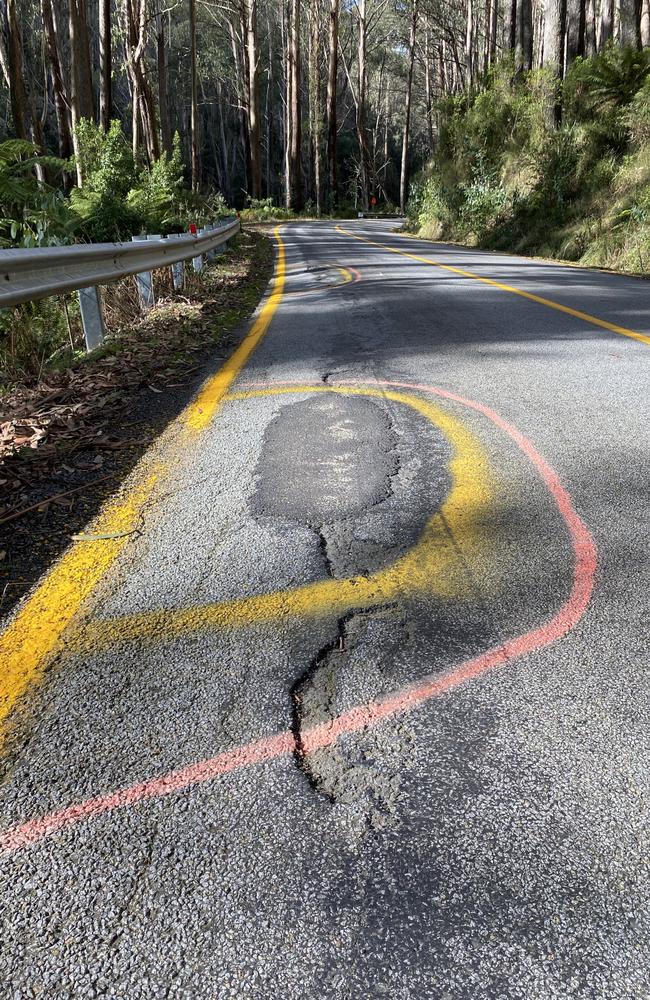Allan government hits brakes on maintaining Vic’s crumbling roads
The Allan government has hit the brakes on maintaining Victoria’s deteriorating roads, sparking fears the state is facing a “maintenance time bomb”.
Victoria
Don't miss out on the headlines from Victoria. Followed categories will be added to My News.
The debt-ridden Allan government has hit the brakes on maintaining Victoria’s crumbling road network with new data showing road resurfacing works have dropped to their lowest levels in more than five years.
With hundreds of regional and metropolitan roads added to the state’s ballooning “roads in poor condition register” and subjected to restrictions because of their poor state, the government last year spent just $37.6m on resurfacing the road network.
It compared to $201.4m the previous year – 435 per cent more than current levels.
Data released to the parliament’s Public Accounts and Estimates Committee showed spending across metropolitan Melbourne has plummeted in recent years, from an average of $82m between 2018 and 2022 to $33m in recent years.
The significant drop in funding comes as the government works to rein in debt with latest forecasts projecting net debt to hit a staggering $188bn by 2027-28.
The government has been accused of stripping funding from its core responsibilities including health amid demands that the state’s hospitals significantly reduce their operating costs.
Concerns about road surface issues have been longstanding and last financial year contributed to at least 1158 claims received by the Department of Transport and Planning for property damage.
It can also be revealed the savage funding cuts came despite direct lobbying to government calling for a commitment to road resurfacing in July last year.
Correspondence sent to Minister for Roads and Road Safety, Melissa Horne, seen by the Herald Sun, warned that “if we don’t continue to reseal our surfaced road network accommodate the service life of the bitumen our road network begins to decline at an accelerating rate.”
“A declining road network rapidly results in the formation of potholes due to a lack of waterproofing leading to more expense base pavement repairs and reconstruction,” it said.
“Our rural main road and highway network has quickly become one that resembles a patchwork quilt with short-term quick fixes becoming the norm.”

As at March 480 regional roads were currently subjected to speed limit reductions or driver warnings due to their poor state.
They include large stretches of road at Bullangarook, in central Victoria, and in Longford, in eastern Victoria, which have been reduced from 100km to 60kmh.
A further 61 metropolitan sites were also under restricted use, totalling almost 840km of the total road network.
Shadow Minister for Roads and Road Safety, Danny O’Brien, said the latest data showed why a government survey had revealed 91 per cent of roads were in poor or very poor condition.
“What’s worse is that this dramatic reduction in road resurfacing and resealing work will lead to worse roads in the coming years,” he said.
“Resealing protects the road network against water penetration that causes potholes and damaged roads.
“By not doing this essential preventive maintenance, Jacinta Allan and Melissa Horne are creating a maintenance time bomb that will explode on Victorians in coming years.”

RACV’s Head of Policy, James Williams, called on both the federal and the Victorian state governments to invest in regional road maintenance and upgrades, with safety as a priority.
“RACV knows the impact that safe roads can have on preventing and minimising car crashes,” he said.
“The Victorian state government collects information relating to the quality of Victoria’s roads, which includes road damage and AusRAP star safety ratings.
“However, more transparency is required on the quality of roads and where road funding is allocated, and RACV supports the Australia Automobile Association in calling on government to publicly release this data.”
A government spokesman blamed “repeated flooding and above-average rainfall” for causing unprecedented damage to the road network.
“We needed to pause resurfacing and focus on rebuilding and strengthening damaged roads, now this work is complete resurfacing levels will significantly increase during the upcoming maintenance season,” she said.
Paint warnings for rider’s sakes
- Ian Royall
A leading motorcycle safety advocate is calling for dangerous potholes on the state’s roads to be painted in bright colours “to give riders a chance”.
Heather Ellis, a long-time rider and former member of the state government’s motorcycle expert advisory panel, said motorcyclists’ lives were at risk because of the poor state of Victoria’s regional roads.
The call comes as the state’s rider death toll for this year has reached 36 – an 80 per cent increase on this time last year, and well above the five-year average of 24.
Popular riding routes such as around Reefton, northeast of Melbourne, need maintenance to fix holes, Ms Ellis said.
Brightly painted lines around deep potholes would “at least give riders a chance” but only as a quick fix, she said.
Ms Ellis said an annual levy that all Victorian riders pay could be used for the painting program.

The motorcycle safety levy, currently $78 a year added to the TAC premium, has been described by rider groups as a tax on motorcyclists.
Critics say money has become a slush fund for state government coffers, and that levy money spent on road projects benefits all road users.
“Some of these potholes are huge and if you’re a motorcyclist you don’t stand a chance,’’ Ms Ellis said.
The author of two motorcycling books, Ms Ellis said the potholes were especially dangerous on shaded roads or around sunset.
“In an ideal world, all potholes would be filled and repaired ASAP. But while we wait, the next best thing is mark every pothole that posed a risk,’’ she said.
Ms Ellis some holes around Lake Mountain had been outlined for repair but were still there months later.
“As we are now in winter it is unlikely the potholes will be repaired until spring,’’ she said.
Victorian Motorcycle Council spokesman John Eacott said funding on road repairs was inadequate.
“Bikes have to be roadworthy, how about roads being motorbike worthy?” he asked.
“Motorbikes are the canary in the coal mine. They are the first group to be impacted by poor road surfaces – which are deadly to two wheels, but not to four.’’
A Victorian government spokesperson said motorcyclists were some of the most vulnerable road users.
“The motorcycle safety levy already funds road upgrades and projects that improve safety for riders.
“Since its introduction in 2002, the motorcycle safety levy has invested more than $100m in a range of targeted safety initiatives across motorcycle policy and law, education and research, and road safety infrastructure improvements for motorcyclists.”
The government raked in about $8m through the levy in the last financial year.
But not all of the money raised since its inception has been spent, leading to accusations of the money being used as a slush fund.




